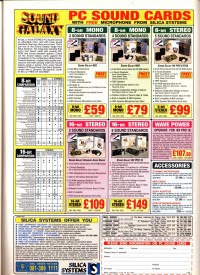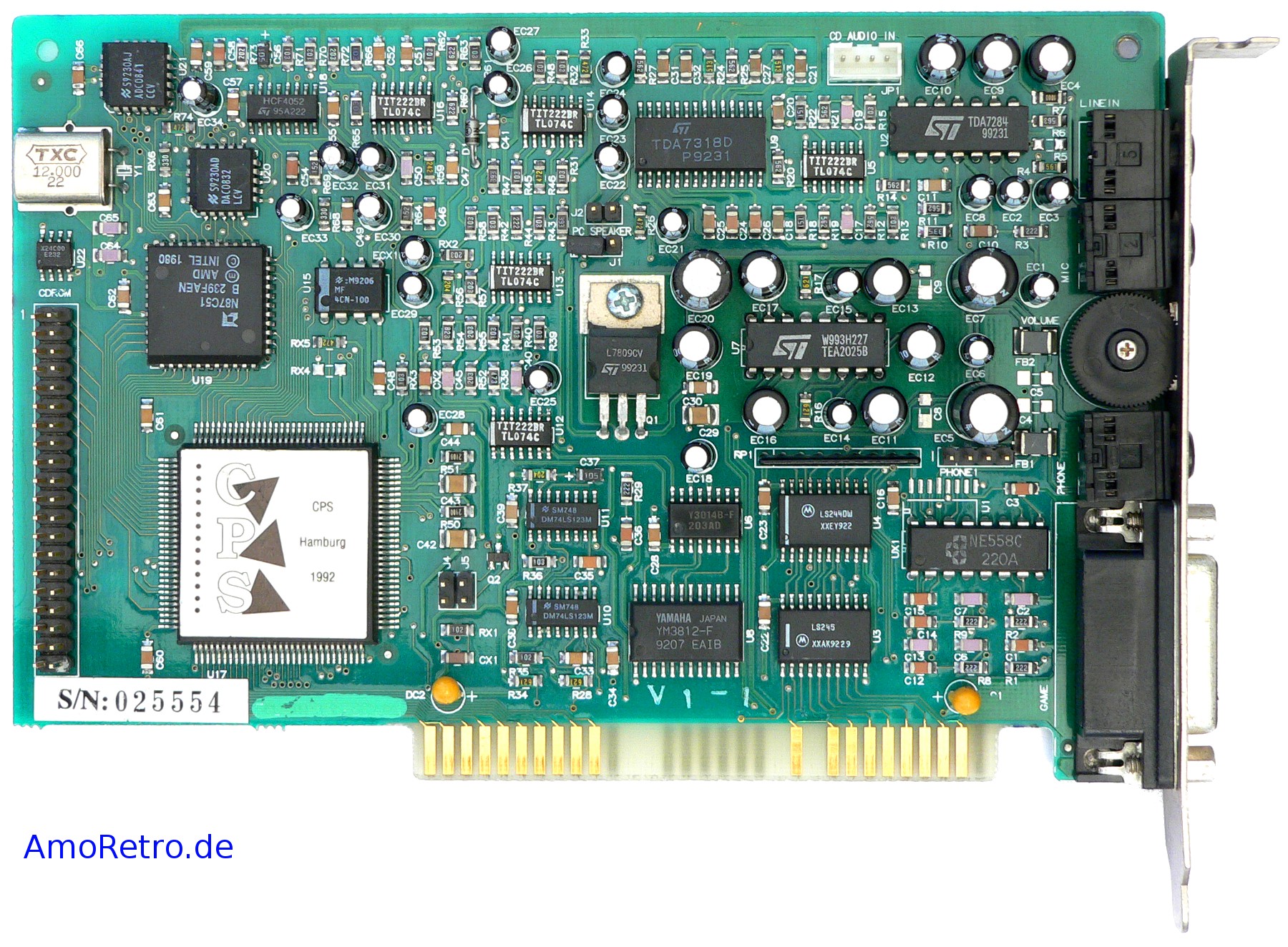Aztech Sound Galaxy NX II / NX II Extra
In 1993, the successor to the Sound Galaxy NX arrived, called Sound Galaxy NX II.
|
Released | Late 1992 / Early 1993 |
| Bus | ISA 8-bit | |
| FM Synth | Yamaha YM3812 (OPL2) | |
| Chipset | AZTSSPT0592-U01 (1st generation card) | |
| Standards | Ad Lib, Sound Blaster 2.5, Covox Speech Thing, Disney Sound Source | |
| Ports | Speaker-Out, Mic-In, Line-In (stereo), thumbwheel volume control Game port |
|
| CD-ROM | Software configuration to switch between Sony, Panasonic or Mitusmi CD-ROM drive | |
| Wavetable | None | |
| Plug & Play | No (but does use Auto-Init for DMA) | |
| FCC ID(s) | I38-MMSD801, I38-SGNX2 | |
| Price | Sep 1993: £79 ex.VAT | |
| See Also | Sound Galaxy BX II, Sound Galaxy NX |
Aside from the tighter chip integration making for a much shorter card, other improvements made to the NXII card over the original NX included a stereo line-in and AGC (automatic gain control), which helped balance the output. The IDE-looking CD-ROM connector actually allows CD-ROMs from Sony, Mitsumi or Panasonic to be connected - the SGCDU.SYS driver has parameters that define which manufacturer of CD-ROM drive is connected.
The card came with a bundled set of speakers, which were the same as those provided with the BXII.
The Aztech AZTSSPT0592-U01 has an internal DSP version of 2.01, and supports up to 44 KHz mono playback and 22 KHz mono recording of digital audio, the same as the BXII which had the earlier AZTSB0792-U07 chipset. It also has an onboard mixer, which mixes line-in, mic-in, CD audio-in and MIDI.
Like the Sound Blaster 2.0/2.5 it mimicked, the NXII added support for "auto-init" (automatic initialising) DMA which allowed the card to produce a continuous loop of double-buffered sound output.
While the card was not PnP, its configuration settings were stored in an EEPROM. Note that the SG2.EXE program (Aztech's version of Creative's DIAGNOSE.EXE) that tests the card after initial installation of the software fails to detect the card - this is a bug - just fully power off, wait, and back on, and try again. Any resource setting changes need this full power-cycle for the setting changes to work.
The NXII was also sold by a company called CPS in Hamburg, Germany.
There was also an NXII Extra - basically the same card but also got a Mitsumi CD-ROM header. It's a 16-bit ISA card but also works in an 8-bit slot as long as you don't use the Mitsumi interface. These cards also come with a jumper, JX1, to enable writing the configuration to the onboard EPROM.
Board Revisions
Several board revisions are known to exist:
Version 1.0 -
Version 1.1 -
Version 1.2 (FCC ID: I38-SGNX2) -
no material differences over 1.1
Version 1.1A and 1.2A (FCC ID: I38-MMSD801) - this is the 16-bit version of the NXII, called NXII Extra.
Pin headers on the NXII cards include CD Audio-in, speaker out and a header for the PC speaker to output PC beeper output through the card to your connected speakers. All NXII cards lack a line-level output, so all audio out goes through the amplifier circuitry.
Competition
At its time of release, Creative Labs were already onto their second generation, with the original Sound Blaster having arrived about 2 years prior, and the Sound Blaster Pro a few months before the Sound Galaxy NX II. Even the Sound Blaster Pro II had launched a few months before, making use of the new Yamaha YMF262 single stereo chip. It is therefore apparent that Aztech's business model was simply to compete at a lower price point than Creative, probably targeting PC-compatible OEMs with discounts on bulk orders. Its strategy with both the BXII and NXII was to entice customers with more coverage of PC sound standards, thus the inclusion of Covox Speech Thing and Disney Sound Source compatibility.
In the Media

A UK advert from September 1993,
advertising several Aztech sound boards
Setting it Up
The two pins at J2 are used to connect your motherboard's PC speaker to the sound card in order to pass PC beeper audio through the card. Jumper J1 just below it is used to set the level of PC beeper amplification (open = low, closed = high).
Jumpers J4 and J5, when set to closed, create a virtual parallel port at port address 278h.
The Aztech installer for the NXII comes up as the "Aztech Sound Galaxy BXII Extra Setup" when run - it is possible this is just a smaller variation in the INSTALL.EXE file that they didn't update (the files are very slightly different size). Other files appear to be very different when comparing the BXII and NXII disks.
It adds the following two lines to AUTOEXEC.BAT:
SET BLASTER=A220 I5 D1 T2SET SOUND=C:\SGNXII
The Covox/Disney support can be disabled using the SGCOX.EXE utility.
Both DOS and Windows 3.1 drivers were included in the two floppy disks included with this card.
Downloads
Operation Manual Get in touch if you can provide this missing item! |
NXII Install Disks Run INSTALL.EXE to begin the installation. |
Windows NT 3.51 Driver Windows NT 3.51 drivers for Sound Galaxy BXII, NXII and NX Pro cards. |
